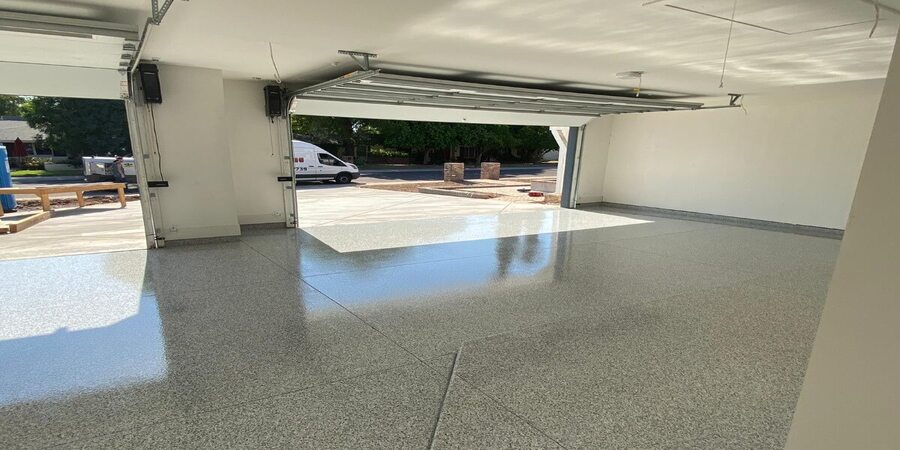
If you’re looking to upgrade your garage with a durable, long-lasting, and aesthetically pleasing flooring solution, epoxy coatings are an excellent choice. Epoxy flooring offers numerous benefits, such as enhanced durability, resistance to chemicals and stains, and a sleek, professional appearance.
However, to ensure a successful installation and maximize the longevity of your garage floor coating, proper preparation is crucial. In this article, we will guide you through the essential steps for preparing your garage floor for epoxy coatings, helping you achieve the best results with your project.
Cleaning the Garage Floor
Before applying epoxy coatings, it is imperative to clean your garage floor thoroughly. This step ensures the removal of any dirt, dust, grease, oil, or other contaminants that may interfere with the adhesion of the epoxy. Follow these cleaning steps:
Clear the Space: Remove all items from your garage floor, including vehicles, tools, and storage items. This will give you ample space to work and ensure that all areas of the floor are accessible.
Sweeping and Vacuuming: Begin by sweeping the floor to remove loose debris, followed by vacuuming to eliminate finer dust particles. A shop vacuum is highly recommended for this purpose.
Degreasing: Use a commercial degreaser or a mixture of warm water and mild detergent to clean any grease or oil stains on the floor. Scrub the stains with a stiff brush and rinse thoroughly to remove all traces of the degreaser.
Etching the Surface: Etching is crucial to promote adhesion between the epoxy coating and the concrete floor. Choose an appropriate etching solution (usually an acid-based product) and follow the manufacturer’s instructions for application. This process will create a slightly rough surface, allowing the epoxy to bond effectively.
Sweeping and Vacuuming: Begin by sweeping the floor to remove loose debris, followed by vacuuming to eliminate finer dust particles. A shop vacuum is highly recommended for this purpose.
Repairing Cracks and Imperfections
Even minor cracks and imperfections can undermine the performance and appearance of your epoxy coating. Therefore, it is essential to address these issues before proceeding with the installation. Here’s what you should do:
Inspect the Floor: Thoroughly examine the garage floor for cracks, divots, or other noticeable imperfections. Pay attention to expansion joints and the edges of the floor as they are common areas for cracks to develop.
Patching and Filling: For smaller cracks, use a concrete patching compound to fill them. Ensure that the compound is specifically designed for use on garage floors and follow the manufacturer’s instructions for the application. For larger cracks or damaged areas, consult a professional concrete repair contractor to assess and repair the floor properly.
Grinding or Sanding: If your floor has rough or uneven areas, consider grinding or sanding to create a smooth surface. This step will also remove any existing coatings or sealers that could interfere with the adhesion of the epoxy.
Addressing Moisture Issues
Moisture can be detrimental to the performance of epoxy coatings. Before applying the epoxy, it’s crucial to check for any moisture issues and take appropriate measures to mitigate them. Follow these steps:
Moisture Testing: Conduct a moisture test on your garage floor to determine if there are any moisture-related issues. Several methods are available, such as the plastic sheet test or the calcium chloride test. Consult with a professional if you are unsure about the testing procedure or interpreting the results.
Vapor Barrier Installation: If high moisture levels are detected, it’s necessary to install a vapor barrier to prevent moisture from seeping through the concrete. A professional contractor experienced in moisture mitigation can assist with the proper installation of a moisture barrier.
Ensuring a Smooth and Suitable Surface
For optimal adhesion and a flawless epoxy coating, the garage floor must be smooth and suitable. Consider the following steps:
Grinding or Shot Blasting: In addition to addressing cracks and imperfections, grinding or shot blasting the floor can help remove any surface contaminants and create a textured profile, allowing the epoxy to adhere better.
Acid Etching (Optional): If you want to further enhance the adhesion, you can perform an additional round of acid etching. This step is particularly useful if you notice that the surface is still too smooth after grinding or shot blasting.
Test for Porosity: Perform a water droplet test on the floor to assess its porosity. Sprinkle a few drops of water on the surface and observe how quickly it is absorbed. If the water beads up and does not absorb within a reasonable time, further surface preparation may be required.
Proper preparation is the key to a successful epoxy floor coating installation in your garage. By following the essential steps outlined in this article, you can ensure that your garage floor is thoroughly cleaned, any cracks or imperfections are addressed, moisture issues are mitigated, and the surface is suitable for optimal adhesion.
Remember, investing time and effort into the preparation process will yield long-lasting, beautiful results for your garage floor. If you’re uncertain about any aspect of the preparation or application, it’s always advisable to consult a professional epoxy flooring contractor who can provide guidance and expertise to help you achieve the best possible outcome.
Key Takeaways:
- Proper preparation is essential for installing epoxy coatings on garage floors.
- Thoroughly clean the garage floor by sweeping, vacuuming, degreasing, and etching to remove contaminants and promote adhesion.
- Repair cracks and imperfections using suitable concrete patching compounds and consult professionals for larger repairs.
- If necessary, address moisture issues by conducting moisture tests and installing a vapor barrier.
- Ensure a smooth and suitable surface by grinding or shot blasting the floor and considering an additional round of acid etching if needed.
- Test the floor’s porosity to ensure proper absorption of water droplets.
- Investing time and effort in preparing will lead to a durable and aesthetically pleasing epoxy coating.
- Consult a professional epoxy flooring contractor for guidance and expertise throughout the preparation and installation process.
